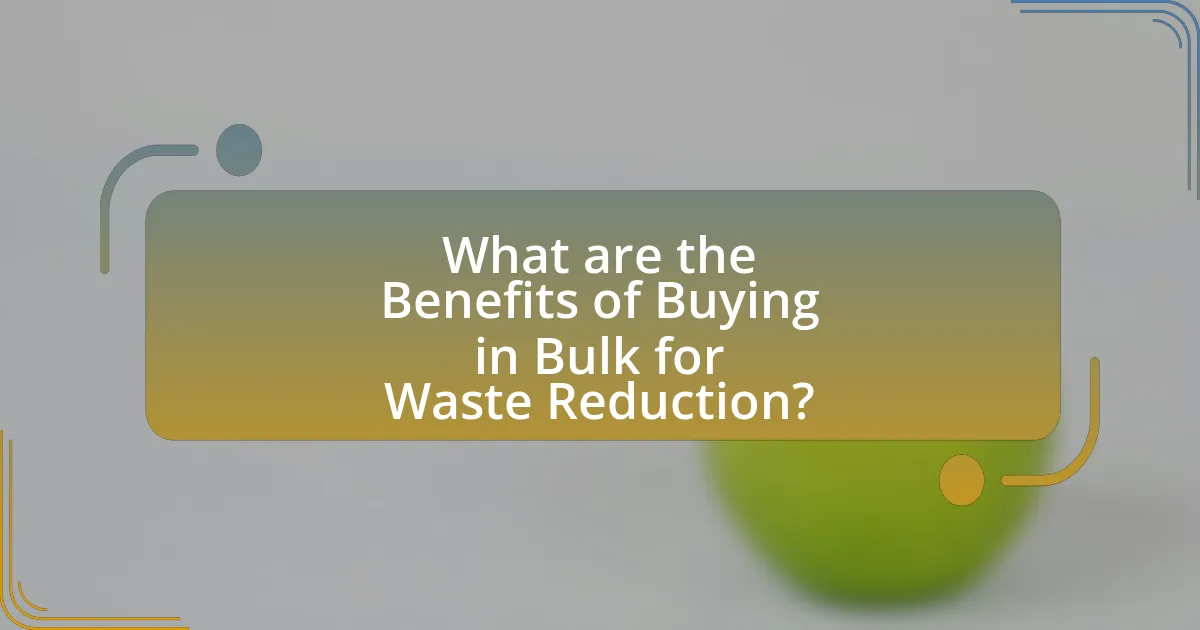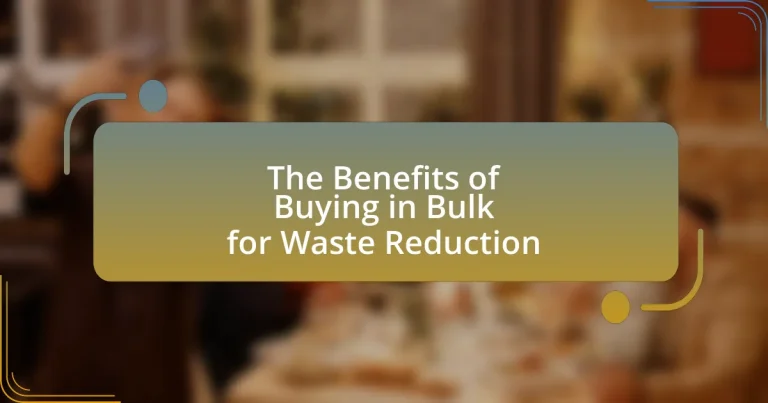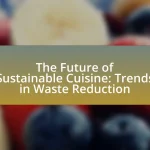The article focuses on the benefits of buying in bulk as a strategy for waste reduction. It highlights how bulk purchasing minimizes packaging waste, decreases food spoilage, and reduces transportation emissions, contributing to environmental sustainability. Key points include the economic advantages of lower per-unit prices and cost savings for consumers and businesses, as well as best practices for effective bulk buying to maximize waste reduction. The article also addresses potential challenges, such as storage limitations and spoilage risks, while emphasizing the importance of informed purchasing decisions to achieve waste reduction goals.

What are the Benefits of Buying in Bulk for Waste Reduction?
Buying in bulk significantly reduces waste by minimizing packaging and excess materials. When consumers purchase larger quantities, they often encounter less individual packaging, which leads to a decrease in plastic and cardboard waste. For instance, a study by the Environmental Protection Agency indicates that bulk purchasing can reduce packaging waste by up to 30%, as fewer items require individual wrapping. Additionally, buying in bulk encourages the use of reusable containers, further contributing to waste reduction. This practice not only benefits the environment but also promotes sustainable consumption habits among consumers.
How does buying in bulk contribute to waste reduction?
Buying in bulk contributes to waste reduction by minimizing packaging waste and encouraging more efficient resource use. When consumers purchase items in larger quantities, they often encounter less packaging per unit, which directly decreases the amount of plastic and cardboard waste generated. For instance, a study by the Environmental Protection Agency indicates that packaging accounts for about 30% of municipal solid waste in the United States. Additionally, buying in bulk can lead to reduced transportation emissions, as fewer trips are needed to deliver larger quantities of goods, further contributing to environmental sustainability.
What types of waste are minimized through bulk purchasing?
Bulk purchasing minimizes several types of waste, including packaging waste, food waste, and transportation waste. By buying in larger quantities, consumers and businesses reduce the amount of packaging materials used per unit, leading to less plastic and cardboard waste. Additionally, bulk purchasing often allows for better inventory management, which can decrease food spoilage and waste, particularly in grocery and food service sectors. Furthermore, fewer trips to suppliers result in reduced transportation emissions and costs, contributing to lower overall environmental impact. These reductions are supported by studies indicating that bulk buying can lead to a significant decrease in the volume of waste generated, promoting sustainability.
How does bulk buying influence packaging waste?
Bulk buying significantly reduces packaging waste by minimizing the amount of individual packaging materials used per unit of product. When consumers purchase items in larger quantities, they often encounter less packaging overall, as bulk products typically utilize fewer materials compared to multiple smaller packages. For instance, a study by the Environmental Protection Agency indicates that bulk purchasing can lead to a reduction in packaging waste by up to 30%, as fewer containers and wrappers are required. This reduction not only lessens the environmental impact associated with production and disposal of packaging but also encourages more sustainable consumption practices among consumers.
Why is waste reduction important for the environment?
Waste reduction is crucial for the environment because it minimizes the amount of waste sent to landfills and reduces pollution. When less waste is generated, there is a decrease in the harmful emissions produced during waste decomposition and incineration, which contributes to air and water pollution. According to the Environmental Protection Agency, reducing waste can significantly lower greenhouse gas emissions, as landfills are a major source of methane, a potent greenhouse gas. Furthermore, waste reduction conserves natural resources by decreasing the demand for raw materials, which in turn reduces habitat destruction and energy consumption associated with resource extraction and processing.
What are the environmental impacts of excessive waste?
Excessive waste has significant environmental impacts, including pollution, habitat destruction, and resource depletion. When waste accumulates in landfills, it produces methane, a potent greenhouse gas that contributes to climate change. Additionally, the leachate from landfills can contaminate soil and groundwater, harming ecosystems and human health. According to the Environmental Protection Agency, landfills are the third-largest source of methane emissions in the United States. Furthermore, excessive waste leads to the over-extraction of natural resources, as more materials are needed to replace discarded items, resulting in deforestation, loss of biodiversity, and increased energy consumption.
How does reducing waste benefit local ecosystems?
Reducing waste benefits local ecosystems by minimizing pollution and conserving natural resources. When waste is reduced, fewer materials end up in landfills, which decreases the release of harmful substances into the soil and water. For instance, the Environmental Protection Agency reports that landfills are a significant source of methane, a potent greenhouse gas. Additionally, reducing waste encourages recycling and composting, which can enhance soil health and promote biodiversity. According to a study published in the journal “Waste Management,” effective waste reduction strategies can lead to a 30% decrease in landfill waste, thereby improving local air and water quality and supporting healthier ecosystems.
What economic advantages does buying in bulk provide?
Buying in bulk provides significant economic advantages, primarily through cost savings and reduced per-unit prices. When consumers purchase larger quantities, they often benefit from wholesale pricing, which can lead to savings of 20% to 50% compared to buying smaller packages. Additionally, buying in bulk minimizes packaging costs, which can further lower the overall expense. Research indicates that bulk purchasing can also reduce transportation costs, as fewer trips are needed to restock, contributing to overall savings. These economic benefits make bulk buying a financially advantageous choice for consumers and businesses alike.
How does bulk purchasing lead to cost savings for consumers?
Bulk purchasing leads to cost savings for consumers primarily through lower per-unit prices. When consumers buy in larger quantities, retailers often provide discounts, which reduces the overall cost per item. For instance, a study by the Consumer Federation of America found that buying in bulk can save consumers up to 30% compared to purchasing smaller packages. Additionally, bulk purchases minimize packaging waste, which can further lower costs associated with disposal and recycling. This combination of reduced prices and decreased waste contributes significantly to the financial benefits of bulk buying for consumers.
What are the long-term financial benefits for businesses?
The long-term financial benefits for businesses include reduced costs, improved cash flow, and increased profitability. By purchasing in bulk, businesses can take advantage of volume discounts, which lower the per-unit cost of goods. This reduction in costs directly contributes to improved cash flow, allowing businesses to allocate resources more efficiently. Additionally, bulk purchasing can lead to increased inventory turnover, minimizing storage costs and reducing waste, which further enhances profitability. According to a study by the National Association of Wholesaler-Distributors, businesses that implement bulk buying strategies can save up to 20% on their overall procurement costs, demonstrating the financial advantages of this approach.
How can consumers effectively buy in bulk to reduce waste?
Consumers can effectively buy in bulk to reduce waste by selecting products with minimal packaging, purchasing only what they need, and choosing items that have a longer shelf life. By opting for bulk bins or refill stations, consumers can significantly decrease the amount of single-use packaging that contributes to landfill waste. Research indicates that buying in bulk can lead to a reduction in packaging waste by up to 30%, as bulk items often use less material compared to individually packaged products. Additionally, consumers should plan their purchases based on consumption patterns to avoid overbuying, which can lead to food waste.
What strategies can be employed to choose bulk products wisely?
To choose bulk products wisely, consumers should assess product quality, compare unit prices, and evaluate storage capabilities. Assessing product quality ensures that bulk items meet personal standards and do not compromise on freshness or effectiveness. Comparing unit prices allows consumers to determine the best value, as bulk purchases often reduce the cost per unit. Evaluating storage capabilities is crucial, as adequate space is needed to store bulk items without spoilage or waste. According to a study by the Food Waste Reduction Alliance, purchasing in bulk can significantly decrease packaging waste, reinforcing the importance of making informed choices when selecting bulk products.
How can consumers store bulk items to minimize waste?
Consumers can store bulk items to minimize waste by using airtight containers, which prevent spoilage and extend shelf life. Airtight containers, such as glass jars or plastic bins, protect food from moisture and pests, reducing the likelihood of waste. Additionally, labeling containers with purchase dates helps consumers track freshness, ensuring items are used before they expire. Research indicates that proper storage can reduce food waste by up to 30%, highlighting the effectiveness of these methods in maintaining the quality of bulk items.
What challenges might arise from buying in bulk?
Buying in bulk can lead to several challenges, including storage issues, potential waste from spoilage, and financial strain. Limited storage space may result in difficulty accommodating large quantities of products, especially perishable items, which can lead to spoilage and waste. According to the Food and Agriculture Organization, approximately one-third of food produced globally is wasted, often due to improper storage and over-purchasing. Additionally, the upfront cost of bulk purchases can strain budgets, particularly for households with limited financial flexibility. These challenges highlight the need for careful planning and consideration when opting to buy in bulk.
How can consumers overcome storage limitations?
Consumers can overcome storage limitations by utilizing vertical space and organizing items efficiently. Implementing shelving units, stackable containers, and under-bed storage can maximize available space. According to a study by the National Association of Professional Organizers, effective organization can increase storage capacity by up to 50%. Additionally, consumers can adopt a minimalist approach, reducing the number of items stored to only essentials, which further alleviates storage constraints.
What are the potential downsides of bulk purchasing?
The potential downsides of bulk purchasing include increased upfront costs, risk of spoilage, and storage challenges. When consumers buy in bulk, they often face a higher initial expenditure, which can strain budgets, especially if the items are not used quickly. Additionally, perishable goods may spoil before consumption, leading to waste, which contradicts the waste reduction goal. Furthermore, bulk items require adequate storage space, which may not be available in all households, resulting in clutter or the need for additional storage solutions. These factors can diminish the overall benefits of bulk purchasing, particularly in terms of waste reduction.
What are the best practices for buying in bulk to maximize waste reduction?
The best practices for buying in bulk to maximize waste reduction include selecting products with minimal packaging, purchasing only what is necessary to avoid spoilage, and choosing items that have a longer shelf life. By opting for bulk items that use less packaging, consumers can significantly reduce the amount of waste generated from single-use containers. Additionally, buying in quantities that match consumption patterns helps prevent food waste, as over-purchasing can lead to spoilage. Research indicates that bulk purchasing can lead to a 30% reduction in packaging waste compared to buying pre-packaged goods.


